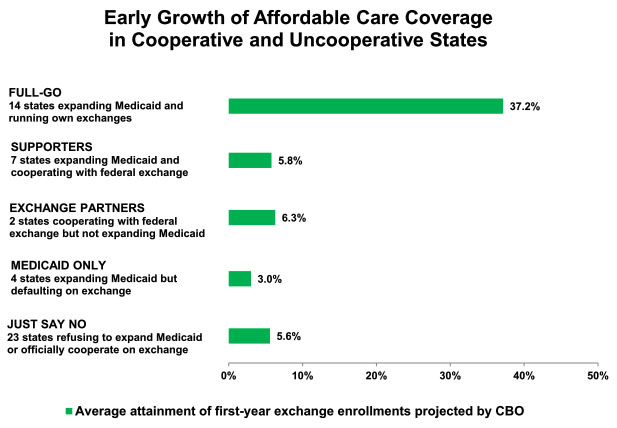
See important updates below.
Dylan Scott points to an interesting chart from Theda Skocpol that shows the signup rate for Obamacare in various states, ranked by how cooperative the various states have been in implementing the law. However, I draw a different conclusion than Scott does. It’s obvious that Medicaid signups are going to be way lower in states that have declined to join the Medicaid expansion, so it’s no surprise that this is exactly what Skocpol finds. What’s more interesting is how state cooperation affects signups on the exchanges. I’ve modified her chart to show only that:

If you take a look at just the exchange signups, it’s obvious that one, and only one, thing matters: whether a state has its own exchange or relies on the federal exchange. States running their own exchanges are well on the way to meeting their first-year goal for signups. States that rely on the federal exchange, no matter how cooperative they are, are barely signing up anyone at all. The disastrous rollout of the federal exchange website has obviously had a far greater impact on Obamacare signups than lack of cooperation in red states.
POSTSCRIPT: That’s assuming these numbers are right, of course. And after looking at them a little more carefully, I don’t think they are. According to year-end tallies, 1.1 million people had signed up for coverage via the federal exchange. However, eyeballing the chart and averaging across all states using the federal exchange, the federal exchange is at 5-6 percent of its first-year goal, which means its first-year goal must have been about 20 million. Likewise, 850,000 people had signed up via state exchanges. If that represents 37 percent of the first-year goal, it means the first-year goal for the state exchanges must have been around 2.3 million.
That number for state exchanges might be about right, but the number for the federal exchange sure isn’t. So I’m not sure what’s going on here.
POSTSCRIPT 2: There’s nothing in Skocpol’s report that says this, but apparently the state data is through January 4 while the federal data is through November 30. This makes comparisons between the two impossible, and it makes the chart above worthless. Please ignore this entire post.















